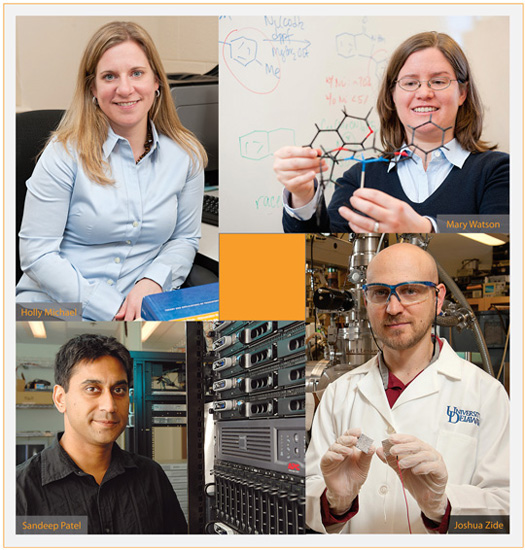
From cells to seawater, scientists earn national acclaim
RESEARCH | Three assistant professors recently received Faculty Early Career Development Awards from the National Science Foundation (NSF), while a fourth was recognized with a similar award from the federal Department of Energy.
Holly Michael of UD's Department of Geological Sciences and Sandeep Patel and Mary Watson, both of the Department of Chemistry and Biochemistry, received the NSF award. The highly competitive award recognizes junior faculty for their role as teacher-scholars and is given to those scientists and engineers considered most likely to become the academic leaders of the 21st century.
Joshua Zide, in the Department of Materials Science and Engineering, received an energy department Early Career Research grant. Those awards are designed to strengthen the nation's scientific workforce by supporting a small number of exceptional researchers during their early career years.
Holly Michael
The most widespread contaminant of groundwater is not a microbe, industrial chemical or harmful element such as arsenic, Michael says. It's seawater.
"Salt is everywhere along the coast," she says. "With sea-level rise, groundwater salinization could become more of an issue."
Michael will use her NSF award to study large-scale movement of water between land and sea with the goal of eventually integrating these processes over the full range of spatial and temporal scales. At the small scale, researchers quantify that groundwater-seawater exchange in relation to waves and sediment ripples. At increasingly larger scales, the perspective expands to tides, seasons, glacial cycles and continental shelves.
"It's important to understand all the scales because they nest within each other," Michael says.
She will use a mathematical approach to study coastal dynamics, comparing two very different places: Bangladesh and Hawaii. The geology of the Bengal Basin consists of interwoven layers of sands and clays, while the structure of the Hawaiian Islands is more continuous, with lava flows having formed structures that can extend out to the ocean.
Michael aims to better understand coastal water flow and salt transport. The research has implications for water resource management, from protecting coastal ecosystems to informing where to install offshore wind farms.
Sandeep Patel
Patel's award will support his research using novel computer modeling methods to study the biophysics of model cell membranes, with particular focus on cell-penetrating peptides.
The award also will support the purchase of a computer cluster for Newark (Del.) High School and the development of a new computational chemistry course to be offered there and team-taught by Patel and two veteran high school science teachers.
"All of our bodies are composed of cells, and between the inside and outside of a cell is what one can loosely consider a barrier, the cell membrane," Patel says in explaining the foundation of his research. "Certain types of molecules—hydrophilic, or 'water-loving,' small molecules and highly charged peptides—can be observed in the membrane, moving very quickly through it, even though it's a very unfavorable environment for them."
In seeking to understand this phenomenon, his group is using computer modeling to obtain atomic-level insights. Longer-term applications, Patel says, might be to use cell-penetrating peptides as a way to deliver drugs to the cells.
The NSF grant also will fund Patel's proposal to engage high school students in science and show them the importance and usefulness of learning about a variety of disciplines even before they arrive on a university campus.
Mary Watson
Watson's award will support her research on the development of new methods to construct organic molecules and her education program to make chemistry more exciting and accessible to potential young scientists.
"Synthetic organic molecules have enormous positive impact on our daily lives, improving everything from our health (medicines) to our entertainment (organic light-emitting diodes, or OLEDs). Future advances rely on increased and more efficient access to complex molecules from simple and readily available building blocks," Watson says.
"The overarching goal of my research program is to discover new ways to make important molecules using catalysts that enable currently impossible transformations and exert exquisite control over which enantiomer, or geometrical isomer, of product is formed."
Enantiomers are pairs of chemical compounds, each with a molecular structure that's the mirror image of the other compound in the pair. Controlling which enantiomer is formed is important, Watson says, because they can exhibit different properties and effects, particularly in biological applications such as medicines.
In announcing the award, the NSF also noted Watson's efforts "to inspire Delaware high school students with the power of chemistry using a video she produced about [former UD Prof.] Richard Heck's Nobel Prize-winning achievements."
Joshua Zide
Zide has spent nearly a decade engineering nanomaterials using a technique called molecular beam epitaxy (MBE).
He makes a class of materials called nanocomposites that consist of metallic nanoparticles within a semiconductor. These nanocomposites can be used in electronic devices such as transistors or in energy conversion devices such as solar cells or thermoelectrics. Typically, these devices are made of semiconductors like silicon or gallium arsenide.
While MBE produces nanoscale materials with exquisite control, the technique is slow and expensive. It also doesn't scale well for industrial applications, and it isn't flexible in allowing the addition of new materials.
Using the Early Career Research grant, Zide will attempt to grow nanoscale materials in a new way, exploring the use of liquid phase epitaxy (LPE) to make nanocomposites for thermoelectrics, which are devices for generating electrical energy from heat. The work shows potential for transitioning these promising materials from the laboratory to the factory, allowing production of innovative electronic, opto-electronic and energy conversion devices.
"Instead of growing nanomaterials at one micron per hour, which is much slower than grass grows, LPE will enable us to grow them at one micron per minute," Zide says.





